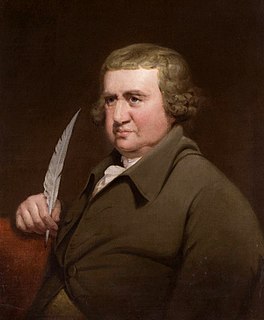
Erasmus Robert Darwin was an English physician. One of the key thinkers of the Midlands Enlightenment, he was also a natural philosopher, physiologist, slave-trade abolitionist, inventor, and poet.

Sir John Chandos, Viscount of Saint-Sauveur in the Cotentin, Constable of Aquitaine, Seneschal of Poitou, was a medieval English knight who hailed from Radbourne Hall, Derbyshire. Chandos was a close friend of Edward the Black Prince and a founding member and 19th Knight of the Order of the Garter in 1348. Chandos was a gentleman by birth, but unlike most commanders of the day he held no inherited title of nobility.
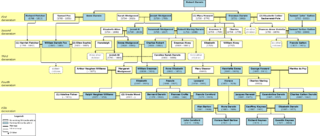
The Darwin–Wedgwood family are members of two connected families, each noted for particular prominent 18th-century figures: Erasmus Darwin, a physician and natural philosopher, and Josiah Wedgwood, a noted potter and founder of the eponymous Wedgwood and Sons pottery company. The Darwin and Wedgwood families were on friendly terms for much of their history and members intermarried, notably Charles Darwin, who married Emma Wedgwood.

Breadsall Priory is a former Augustinian priory in Derbyshire, situated around two kilometres north of Breadsall, and two kilometres east of Little Eaton. The priory was established before 1266 by a member of the Curzon family. Only a small priory, Breadsall was dissolved in 1536.
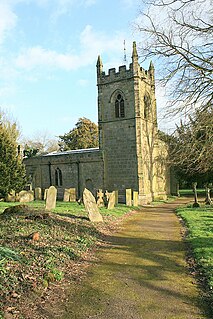
Radbourne is a small village and civil parish in the English county of Derbyshire, a few miles west of Derby. As the population of the civil parish taken at the 2011 census was less than 100 details are included in the civil parish of Etwall.

The Sitwell Baronetcy, of Renishaw in the County of Derby, is a title in the Baronetage of the United Kingdom. It was created on 3 October 1808 for Sitwell Sitwell, Member of Parliament for West Looe. The Sitwell family had been ironmasters and landowners in Eckington, Derbyshire, for many centuries.

This is a list of Sheriffs of Derbyshire from 1567 until 1974 and High Sheriffs since.
The High Sheriff of Tipperary was the Sovereign's judicial representative in County Tipperary. Initially an office for lifetime, assigned by the Sovereign, the High Sheriff became annually appointed from the Provisions of Oxford in 1258. Besides his judicial importance, he had ceremonial and administrative functions and executed High Court Writs.
Admiral George Anson Byron, 7th Baron Byron was a British nobleman, naval officer, peer, politician, and the seventh Baron Byron, in 1824 succeeding his cousin the poet George Gordon Byron, 6th Baron Byron in that peerage. As a career naval officer, he was notable for being his predecessor's opposite in temperament and lifestyle.

Umberleigh is a former large manor within the historic hundred of (North) Tawton, but today a small village in North Devon in England. It used to be an ecclesiastical parish, but following the building of the church at Atherington it became a part of that parish. It forms however a part of the civil parish of Chittlehampton, which is mostly located on the east side of the River Taw.
There have been three baronetcies created for persons with the surname Pole, one in the Baronetage of England, one in the Baronetage of Great Britain and one in the Baronetage of the United Kingdom. Two of the creations are extant as of 2008.
John Yarde-Buller, 2nd Baron Churston was a British peer and soldier.
Sir Francis Foljambe, 1st Baronet was Member of Parliament for Pontefract in 1626 and High Sheriff of Derbyshire in 1633.
Edward Sacheverell Chandos-Pole was a Guards officer and High Sheriff of Derbyshire in 1827.
The Sheriff of Nottinghamshire, Derbyshire and the Royal Forests is a position established by the Normans in England.
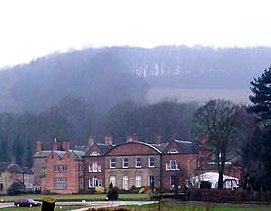
Hopton Hall is an 18th-century country house at Hopton, near Wirksworth, Derbyshire. It is a Grade II listed building.
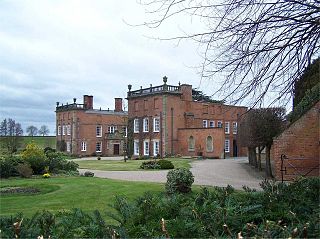
Longford Hall is a 16th-century country house at Longford in the Dales district of Derbyshire, England. It is a Grade II* listed building.

Henry Chandos Pole Gell was a High Sheriff of Derbyshire in 1867. He took the additional surname Gell when he inherited the Gell fortune in 1842.

The Derby Philosophical Society was a club for gentlemen in Derby founded in 1783 by Erasmus Darwin. The club had many notable members and also offered the first institutional library in Derby that was available to some section of the public.
Lieutenant-General Edward Pole was an officer of the British Army.













